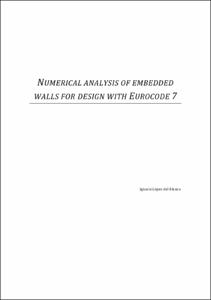Mostra el registre d'ítem simple
Numerical analysis of embedded walls for design with Eurocode 7
| dc.contributor | Gens Solé, Antonio |
| dc.contributor.author | López del Blanco, Ignacio |
| dc.contributor.other | Universitat Politècnica de Catalunya. Departament d'Enginyeria del Terreny, Cartogràfica i Geofísica |
| dc.date.accessioned | 2012-01-23T13:13:40Z |
| dc.date.available | 2012-01-23T13:13:40Z |
| dc.date.issued | 2011-10-20 |
| dc.identifier.uri | http://hdl.handle.net/2099.1/14007 |
| dc.description.abstract | Anglès: The possibility of applying numerical methods, particularly Finite Element Models (FEM), for geotechnical design permits to cope with more complexity and therefore model reality with better accuracy and precision. Elaborated models are relatively inexpensive, increasingly less time-consuming and can be aided by commercial software. The introduction of Eurocodes has changed the standard lumped factored practise to geotechnical design in the direction of limit state analysis and partial factoring. As a result, the implementation of numerical models is more complicated, raising issues on how to apply partial factors of safety, particularly in the strength parameters. Finite Element Methods are considered a valid tool for design in Eurocode 7. However, guidelines are provided typically on limit equilibrium models. The application of partial factors of safety is regulated by the design approaches in Eurocode 7. When using FEM, the application of partial safety factors in the soil strength parameters can be considered by means of two methods: · Numerical simulation with characteristic values without factoring as an input. Then in a required Ultimate Limit State check stage the software undertakes a stepped reduction of strength parameters until geotechnical failure occurs and the factor of safety is determined. · Factored strength parameters are the input of the analysis. No failure occurring in any stage implies satisfying the requirements from the code. Eurocode 7 gives no guidance on which of these two approaches is more appropriate; neither on the appropriate algorithm to perform the required strength reduction during the analysis in the first approach mentioned. As long as the results may differ between the procedures for the same input, developing guidelines is considered necessary. The objective of this project is to apply the above methods to the case of a retaining wall and assess the suitability of the approaches for predicting the ultimate limit state. Special attention is to be put on bringing to light the effect of the dilation angle. |
| dc.language.iso | eng |
| dc.publisher | Universitat Politècnica de Catalunya |
| dc.rights | Attribution-NonCommercial-ShareAlike 3.0 Spain |
| dc.rights.uri | http://creativecommons.org/licenses/by-nc-sa/3.0/es/ |
| dc.subject | Àrees temàtiques de la UPC::Enginyeria civil |
| dc.subject.lcsh | Retaining walls |
| dc.subject.lcsh | Walls |
| dc.subject.other | embedded walls |
| dc.subject.other | Eurocode 7 |
| dc.title | Numerical analysis of embedded walls for design with Eurocode 7 |
| dc.type | Minor thesis |
| dc.subject.lemac | Murs |
| dc.rights.access | Open Access |
| dc.audience.educationlevel | Estudis de primer/segon cicle |
| dc.audience.mediator | Escola Tècnica Superior d'Enginyers de Camins, Canals i Ports de Barcelona |
| dc.audience.degree | ENGINYERIA DE CAMINS, CANALS I PORTS (Pla 1995) |




